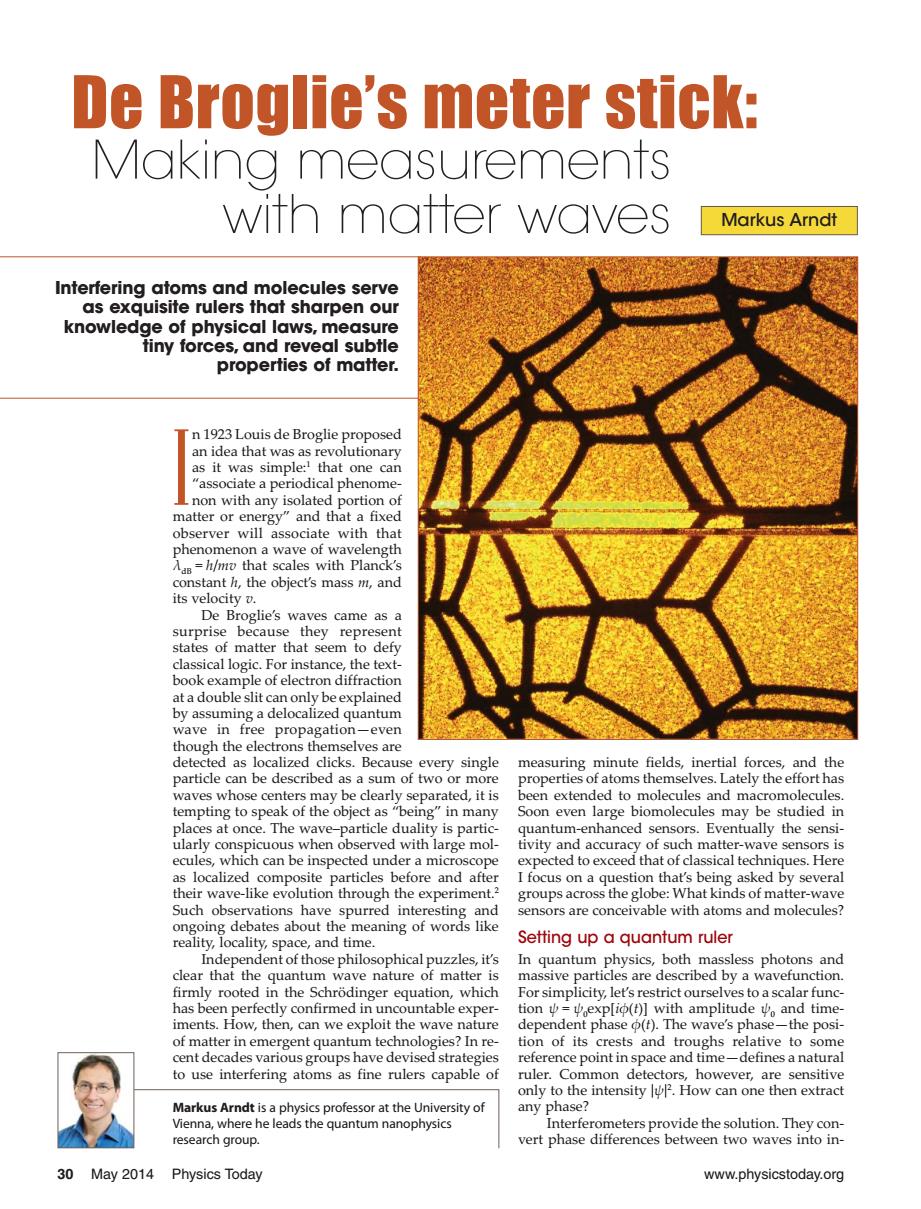正在加载图片...

De Broglie's meter stick: Making measurements with matter waves Markus Arndt Interfering atoms and molecules serve as exquisite rulers that sharpen our knowledge of physical laws,measure tiny forces,and reveal subtle properties of matter. n 1923 Louis de Broglie proposed an idea that was as revolutionary as it was simple:!that one can 'associate a periodical phenome- non with any isolated portion of matter or energy"and that a fixed observer will associate with that phenomenon a wave of wavelength AaB=h/mo that scales with Planck's constant h,the object's mass m,and its velocity v. De Broglie's waves came as a surprise because they represent states of matter that seem to defy classical logic.For instance,the text- book example of electron diffraction at a double slit can only be explained by assuming a delocalized quantum wave in free propagation-even though the electrons themselves are detected as localized clicks.Because every single measuring minute fields,inertial forces,and the particle can be described as a sum of two or more properties of atoms themselves.Lately the effort has waves whose centers may be clearly separated,it is been extended to molecules and macromolecules. tempting to speak of the object as "being"in many Soon even large biomolecules may be studied in places at once.The wave-particle duality is partic- quantum-enhanced sensors.Eventually the sensi- ularly conspicuous when observed with large mol- tivity and accuracy of such matter-wave sensors is ecules,which can be inspected under a microscope expected to exceed that of classical techniques.Here as localized composite particles before and after I focus on a question that's being asked by several their wave-like evolution through the experiment.? groups across the globe:What kinds of matter-wave Such observations have spurred interesting and sensors are conceivable with atoms and molecules? ongoing debates about the meaning of words like reality,locality,space,and time. Setting up a quantum ruler Independent of those philosophical puzzles,it's In quantum physics,both massless photons and clear that the quantum wave nature of matter is massive particles are described by a wavefunction. firmly rooted in the Schrodinger equation,which For simplicity,let's restrict ourselves to a scalar func- has been perfectly confirmed in uncountable exper- tionψ-中exp[iφ(t)]with amplitude vo and time- iments.How,then,can we exploit the wave nature dependent phase o(t).The wave's phase-the posi- of matter in emergent quantum technologies?In re- tion of its crests and troughs relative to some cent decades various groups have devised strategies reference point in space and time-defines a natural to use interfering atoms as fine rulers capable of ruler.Common detectors,however,are sensitive only to the intensity How can one then extract Markus Arndt is a physics professor at the University of any phase? Vienna,where he leads the quantum nanophysics Interferometers provide the solution.They con- research group. vert phase differences between two waves into in- 30 May 2014 Physics Today www.physicstoday.org30 May 2014 Physics Today www.physicstoday.org I n 1923 Louis de Broglie proposed an idea that was as revolutionary as it was simple:1 that one can “associate a periodical phenomenon with any isolated portion of matter or energy” and that a fixed observer will associate with that phenomenon a wave of wavelength λdB = h/mv that scales with Planck’s constant h, the object’s mass m, and its velocity v. De Broglie’s waves came as a surprise because they represent states of matter that seem to defy classical logic. For instance, the textbook example of electron diffraction at a double slit can only be explained by assuming a delocalized quantum wave in free propagation—even though the electrons themselves are detected as localized clicks. Because every single particle can be described as a sum of two or more waves whose centers may be clearly separated, it is tempting to speak of the object as “being” in many places at once. The wave–particle duality is particularly conspicuous when observed with large molecules, which can be inspected under a microscope as localized composite particles before and after their wave-like evolution through the experiment.2 Such observations have spurred interesting and ongoing debates about the meaning of words like reality, locality, space, and time. Independent of those philosophical puzzles, it’s clear that the quantum wave nature of matter is firmly rooted in the Schrödinger equation, which has been perfectly confirmed in uncountable experiments. How, then, can we exploit the wave nature of matter in emergent quantum technologies? In recent decades various groups have devised strategies to use interfering atoms as fine rulers capable of measuring minute fields, inertial forces, and the properties of atoms themselves. Lately the effort has been extended to molecules and macromolecules. Soon even large biomolecules may be studied in quantum-enhanced sensors. Eventually the sensitivity and accuracy of such matter-wave sensors is expected to exceed that of classical techniques. Here I focus on a question that’s being asked by several groups across the globe: What kinds of matter-wave sensors are conceivable with atoms and molecules? Setting up a quantum ruler In quantum physics, both massless photons and massive particles are described by a wavefunction. For simplicity, let’s restrict ourselves to a scalar function ψ = ψ0exp[iϕ(t)] with amplitude ψ0 and timedependent phase ϕ(t). The wave’s phase—the position of its crests and troughs relative to some reference point in space and time—defines a natural ruler. Common detectors, however, are sensitive only to the intensity ∣ψ∣ 2 . How can one then extract any phase? Interferometers provide the solution. They convert phase differences between two waves into inMarkus Arndt is a physics professor at the University of Vienna, where he leads the quantum nanophysics research group. Interfering atoms and molecules serve as exquisite rulers that sharpen our knowledge of physical laws, measure tiny forces, and reveal subtle properties of matter. De Broglie’s meter stick: Making measurements with matter waves Markus Arndt This article is copyrighted as indicated in the article. Reuse of AIP content is subject to the terms at: http://scitation.aip.org/termsconditions. Downloaded to IP: 202.120.2.30 On: Thu, 01 May 2014 23:26:12